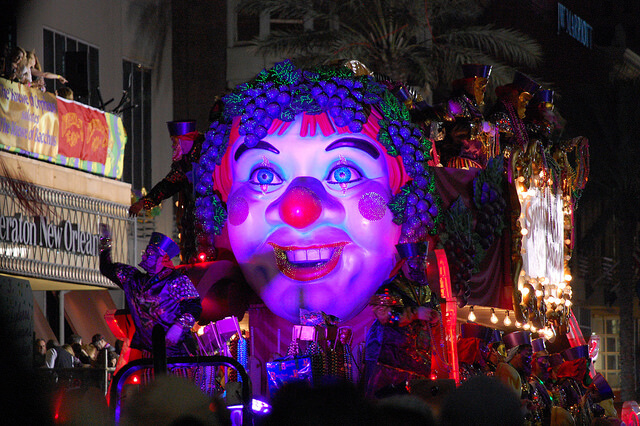New Orleans may not be the first city to celebrate Mardi Gras, but we’ve perfected the celebration since the 1730s. Learn how New Orleans Mardi Gras evolved from a humble start to society clubs to an inclusive and festive environment for tourists and locals.

Krewe of Bacchus is a crowd favorite at Mardi Gras. (Photo courtesy Julie Gibson on Flickr)
Modest Beginnings
In 1702, Jean Baptiste le Moyne Sieur de Bienville (the founder of New Orleans) established Fort Louis de la Louisiane, which is now Mobile, Alabama. The following year, Mobile celebrated America’s very first Mardi Gras. In 1704, the private organizations created a secret society for Mardi Gras, which was a precursor to modern-day krewes.
By the time Sieur de Bienville established New Orleans in 1718, Mobile’s Mardi Gras celebration flourished. It would not take long for New Orleans to follow.
New Orleans Mardi Gras evolved over the next few decades, turning into a full season with the first reference to Carnival appearing in 1729. That same year, the Perseverance Benevolent and Mutual Aid Association became the first carnival organization with hundreds to follow.
Although Mobile might have started the Mardi Gras tradition in the United States, New Orleans proved its willingness to observe the holiday to fullest effect. To this day, New Orleans remains the premiere place in the United States to celebrate Mardi Gras.
Lavish Celebrations
As Mardi Gras paraded on through the 1830s, it began to look more like celebrations of today. Processions with flambeaux torches shed light on dazzling masked horseback riders and decorated carriages. The first New Orleans Mardi Gras krewe, the Krewe of Comus, started in 1856 and still rides today; the second krewe, the Twelfth Night Revelers, began in 1870 and started the tradition of tossing “throws” to parade watchers.
In 1872, another tradition began: Rex, King of Carnival, started that year, naming his colors of purple, green, and gold to honor Russian Archduke Alexis Romanoff, who was visiting at the time.
The next few years saw the birth of even more traditions. In 1873, float production moved from France to New Orleans, and in 1875, the governor cemented Fat Tuesday as a state holiday in Louisiana when he signed the Mardi Gras Act.
Changing Times and the Krewe of Bacchus
Mardi Gras krewes started as private and restrictive clubs that limited participation not only for many locals but also visiting tourists. In 1949, restaurateur Owen Edward Brennan had an idea. He established the Krewe of Bacchus and the grand celebration Bacchus Bash, made krewe membership available to everyone, and effectively changed Mardi Gras forever.
Brennan’s krewe caught on permanently in 1969 when his sons carried on his inclusive attitude. The brothers broke with more than 100 years of tradition by staging the Bacchus parade on Sunday night; using the biggest, most elaborate floats; showering spectators with beads; and choosing a celebrity king, Danny Kaye.
The Krewe of Bacchus’ and the invention of the Super Krewe revitalized Mardi Gras and invigorated our tourism industry. By creating a bigger, more inclusive parade celebration the weekend before Mardi Gras, we welcome tourists to share the unforgettable memories of a New Orleans Mardi Gras with others and spread the word that our city is truly like no other.